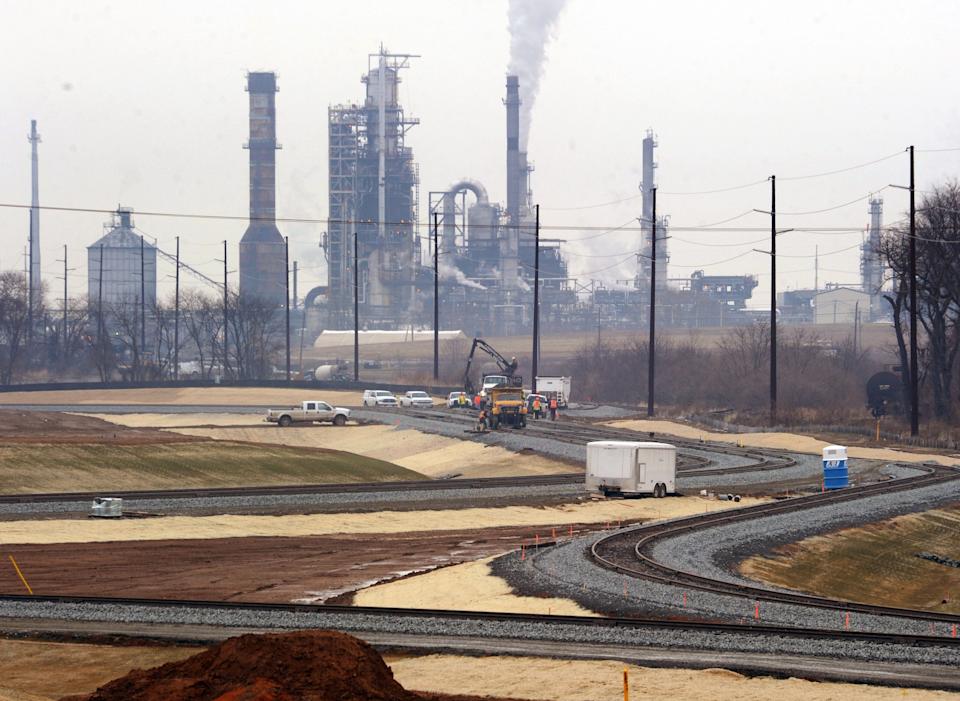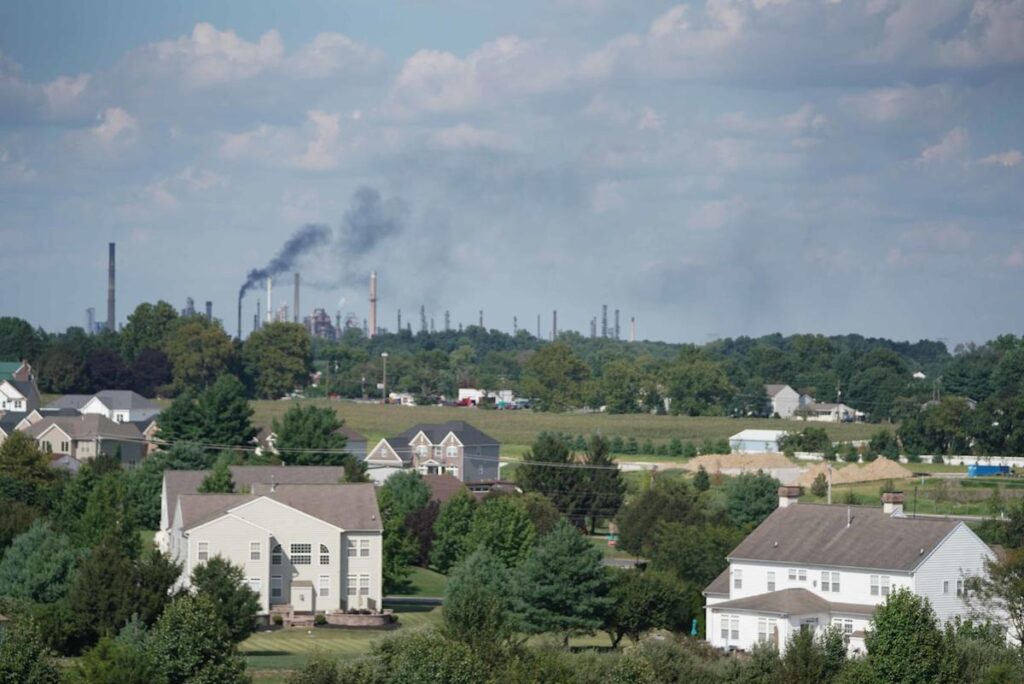The Delaware City Refinery has been continuously releasing more than permitted amounts of toxic sulfur dioxide into the air for a week now, yet there are still more questions than answers.
Here’s what we know.
What is the Delaware City Refinery?
The Delaware City Refinery is located on 5,000 acres just north of Delaware City, along the Delaware River, with a New Castle address.
It’s owned by PBF Energy, “one of the largest independent petroleum refiners and suppliers of unbranded transportation fuels, heating oil, petrochemical feedstocks, lubricants and other petroleum products in the United States,” according to the company’s website.
Black smoke is omitted from a stack on the ground of the Delaware City Refinery.
The Delaware City Refinery is “one of the largest and most complex refineries on the East Coast,” the website says, and can process up to 180,000 barrels of oil per day.
Historically, the Delaware City Refinery has been the state’s biggest polluter, frequently cited for air pollution violations. In October 2024, the Delaware Department of Natural Resources and Environmental Control found that the refinery had deviated from its permit standards nine times between September 2022 and August 2023 and fined the refinery $75,000.
More than 86,000 people live within a 5-mile radius of the refinery, over half of whom are people of color and 20% of whom are lower-income, according to EPA data. Due to concerns with diversity, equity and inclusion, earlier this year, the EPA canceled a $500,000 grant that would have allowed the nonprofit Clean Air Council to monitor air pollution in the area of the refinery.
What is sulfur dioxide?
Sulfur dioxide is a gas composed of sulfur and oxygen. It forms when fuel such as oil, like at the Delaware City Refinery, is burned.
Background: Air monitor shows pollutant from Delaware City Refinery in acceptable range: DNREC
Sulfur dioxide can make it hard to breathe and harm the human respiratory system, according to the Environmental Protection Agency. It can also harm animals and plants.
Delaware Environmental Release Notification System, which reports on the Delaware City Refinery releases, says sulfur dioxide “may cause death or permanent injury after very short exposure to small quantities.”
Signs of acute sulfur dioxide exposure include symptoms such as coughing, shortness of breath, wheezing, fatigue, chest discomfort, nausea, vomiting, stomach pain and cyanosis, the reports say. People with asthma, subnormal pulmonary functions or cardiovascular disease are at a greater risk than others.
The fossil fuel industry is the largest contributor of sulfur dioxide into the atmosphere, according to the EPA. Refineries like the Delaware City Refinery are typically allowed to emit certain amounts of pollutants into the air and water through state and federal permits.
How much sulfur dioxide has been released in this incident and how much is unsafe?
The release of sulfur dioxide is ongoing and will continue “until the repairs are made,” a May 31 Delaware Environmental Release Notification System report says.

The Delaware City Refinery is located on 5,000 acres along the Delaware River.
The refinery’s air quality permit doesn’t appear to be available online, so how much sulfur dioxide the company is normally permitted to release is unknown.
According to reports publicly posted on the Delaware Environmental Release Notification System website, the following amounts of sulfur dioxide were released by the Delaware City Refinery since May 25.
-
11:30 p.m., May 25: “over 100 pounds”
-
12:01 a.m., May 26: “greater than 500 pounds”
-
9:55 a.m., May 28: 500 pounds per hour
-
11:16 a.m., May 29: 1,450 pounds per hour
-
10:05 a.m., May 30: 1,450 pounds per hour
-
9 p.m., May 31: “greater than 500 pounds”
The Delaware Department of Natural Resources and Environmental Control issued a news release related to these incidents on May 31. It noted information from an air monitoring station east of the refinery on Route 9, but didn’t state the direction in which the wind was blowing at the time the information was recorded.
Related: Delaware City Refinery ‘deviated’ from its permit 7 times in 2024 with no violations
The “health standard” for sulfur dioxide, according to the news release, is 75 parts per billion. The highest hourly measurement during “this incident” was 25 parts per billion for 6 a.m. on May 31, the release said. The highest-recorded daily average sulfur dioxide level was 2.5 parts per billion on May 26. When the news release was issued on May 31, the average was 7.33 parts per billion.
Since the news release was issued, more data has become available on the department’s Air Quality Monitoring Network website. It shows a new highest hourly measurement of 29 parts per billion at midnight on June 1.
What is causing the release?
Some DERNS reports cite “a boiler failure.”
DNREC and PBF representatives did not immediately respond to questions.
Why haven’t nearby citizens been notified?
DERNS sends out notifications of chemical releases, but only to people who have signed up.
DNREC spokesman Michael Globetti said concerning a past chemical release that DERNS is “not intended to be an emergency notification system, but rather a system to allow citizens to stay informed.”
The Department of Emergency Management Agency has sent out notifications of past chemical releases, but Director A.J. Schall said they haven’t sent out any releases related to the current refinery incident.
Why hasn’t the refinery shut down operations?
It’s unknown. DNREC and PDF representatives did not immediately respond to questions.
Molly McVety contributed to this story. Shannon Marvel McNaught reports on southern Delaware and beyond. Reach her at [email protected] or on Facebook.
This article originally appeared on Delaware News Journal: Delaware City Refinery continues to release toxic chemical into air
Read the full article here


